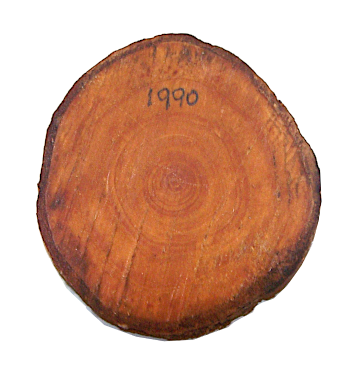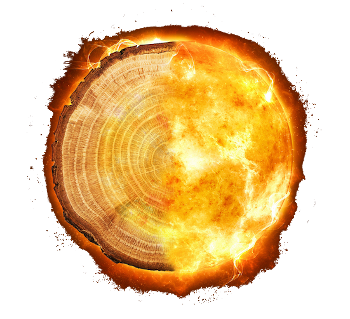
Tree Rings and Cosmic Rays
January 2, 2023 About two decades ago I volunteered to create a website for our local historical society. The initial step was a series of meetings with the members of the organization to decide on content. The main purpose of the society was the maintenance of several buildings, including a former general store, built in the first days of our our township. Our planning meetings were held in one of those buildings. None of the historical society people had a scientific background. I noticed that the building was constructed from bare timbers that clearly exposed the growth ring structure of their parent tree; so, I gave them an impromptu lecture on how those rings could be used to date the structure. The science of tree ring analysis is called dendrochronology from the Greek words, δένδρον (dendron, tree), χρόνος (khronos, time), and -λογία (-logia, the study of).
Growth rings of a seven year old Christmas tree.
When my children were younger, we would cut our own Christmas tree at a local Christmas tree farm.
A fresh cut of the stump ensured adequate water uptake by the tree, and we would often retain the cut piece, as shown here.
The wood was quite dry after 32 years, so I rubbed this piece with mineral oil to accentuate the ring structure.
(Click for larger image.)
The Greek botanist, Theophrastus (c.371 BC - c.287 BC) was the first to write that tree wood has a layered texture, like an onion, although he did not conjecture a reason for this.[1] Leonardo da Vinci (1452-1519), in his Trattato della Pittura (Treatise on Painting), was the first to write that tree rings are formed annually, and that their thickness is an indicator of the tree's growth conditions; viz.,[2]
Li circuli delli rami degli alberi segati mostrano il numero delli suoi anni, e quali furono più umidi o più secchi la maggiore o minore loro grossezza.Trunk growth in trees happens at the periphery in a layer of cells near the bark. When water is plentiful and the growing season is long, a wide ring is added, while a drought will produce a narrow ring, each ring marking a year's growth. Trees grown in temperate zones in which the seasons are markedly different, have more visible rings, an example being the fir tree in the upper image. The one-ring-per-year rule is not exact, since several rings can form in a year in response to conditions such as a mid-summer drought. The pattern of ring widths will indicate the particular historical period in which the tree grew, and such analysis is aided by a standard data set derived from oxygen isotope analysis. As I wrote in a earlier article (The Year 536, March 18, 2019), there was an extreme weather event in the 6th century, starting around the years 535-536.[3-4] The cause of this has been shown by scientific study to have a volcanic origin.[3-4] As Byzantine historian, Procopius (c.500 - c.554), wrote in his History of the Wars, Book IV, Chapter XIV,
The circles of the branches of sawn trees show the number of its years, and which were wetter or drier the greater or lesser thickness.
For the Sun gave forth its light without brightness, like the Moon, during this whole year, and it seemed exceedingly like the Sun in eclipse, for the beams it shed were not clear nor such as it is accustomed to shed.[5]Tree ring studies revealed that the years around 540 were unusually cold.[3-4] Summer temperatures in 536 were 1.5°C to 2.5°C lower, and this was the start of the coldest decade in the past 2300 years.[4] This catastrophe was followed closely by the Plague of Justinian, 541–549, caused by the same Yersinia pestis bacterium responsible for the Black Death of 1347–1351. Tree ring analysis for accurate dating of when a specimen of wood was created was used to advantage in a recent study examining periods of increased cosmic irradiation of the Earth. Neutrons in cosmic rays interact with 14N atoms in the upper atmosphere to produce radioactive 14C, which enters Earth's global carbon cycle and is incorporated into plants, including trees.[6] Living organisms will continually incorporate 14C during their lifetime, but this isotope in dead organic matter decays with a half-life of 5700-years.[6]

Composite image of tree rings (left) and the Sun (right).
Radiation spikes in tree ring data were thought to be the result of irradiation of the Earth by solar events such as coronal mass ejections.
Recent evidence indicates that the irradiation was too intense to have been caused by the Sun. An extrasolar origin is suspected.
(University of Queensland image.)
This research, published as an open access paper in the Proceedings of the Royal Society, was conducted by members of the University of Queensland (Queensland, Australia), the University of Groningen (Groningen, The Netherlands), the University of Cambridge (Cambridge, United Kingdom), the Czech Academy of Sciences (Brno, Czech Republic), Masaryk University (Brno, Czech Republic), the Swiss Federal Research Institute (Birmensdorf, Switzerland), the University of Reading (Reading, United Kingdom), and the University of Southern Queensland (Queensland, Australia).[6-7] The Sun irradiates Earth's atmosphere through such phenomena as coronal mass ejections.[6] Tree ring evidence, however, indicates irradiation events nearly two orders of magnitude larger than that from solar events.[6] These events, called Miyake events after their discovery in Japanese cedar tree-rings by Fusa Miyake and his colleagues in 2012, appear to have an extrasolar origin.[8] Miyake found that such event happened in 993 AD, and subsequent events were found for 663 BC, 5259 BC, 5410 BC, and 7176 BC.[6] Possible origins for such irradiation of the Earth are gamma-ray bursts, a nearby supernova, or a magnetar burst from a nearby magnetized neutron star.[6]

Miyake Events of 663 BC, 5259 BC, and 7176 BC, showing the steep rise in carbon-14 over a period of about a year, and a decade's long decay. This figure is just illustrative, since errors would have been introduced during data transcription. Consult the copyrighted original for precise data. (Created using Gnumeric and Inkscape from data in fig. 2 of ref. 6.[6] Click for larger image.)
If such events were to happen today, such a dramatic rise in cosmic radiation would affect Earth's biosphere and much of our technology. Irradiation two orders of magnitude larger than a coronal mass ejection would damage satellites and power transmission lines.[6] An event of the order of the 774 Miyake Event would deplete about 8.5% of global ozone.[6] Says research team leader, Benjamin Pope of the University of Queensland School of Mathematics and Physics,
"These huge bursts of cosmic radiation, known as Miyake Events, have occurred approximately once every thousand years but what causes them is unclear... We need to know more, because if one of these happened today, it would destroy technology including satellites, Internet cables, long-distance power lines and transformers... Based on available data, there's roughly a one per cent chance of seeing another one within the next decade... These odds are quite alarming..."[7]
References:
- Loeb Classic Library Theophrastus, "Enquiry into Plants," vol. I, book V, p. 423, Arthur Holt, Trans., Loeb Classical Library (William Heinemann, London:1916), via archive.org.
- Leonardo da Vinci, "Trattato della Pittura," Rome, 1817, p. 396, via archive.org. English translation via Google Translate.
- Ann Gibbons, "Eruption made 536 'the worst year to be alive'," Science, vol. 362, no. 6416 (November 16, 2018), pp. 733-734, DOI: 10.1126/science.362.6416.733.
- Ann Gibbons, "Why 536 was 'the worst year to be alive'," Science (November 15, 2018), doi:10.1126/science.aaw0632.
- Procopius, "History of the Wars," Book IV (The Vandalic War (pt. 2)), Chapter XIV, via Wikisource.
- Qingyuan Zhang, Utkarsh Sharma, Jordan A. Dennis, Andrea Scifo, Margot Kuitems, Ulf Büntgen, Mathew J. Owens, Michael W. Dee, and Benjamin J. S. Pope, "Modelling cosmic radiation events in the tree-ring radiocarbon record," Proc. R. Soc. A, vol. 478, no.2266 (October 26, 2022), DOI:https://doi.org/10.1098/rspa.2022.0497. This is an open access article with a PDF file here.
- Tree rings offer insight into devastating radiation storms, University of Queensland Press Release, October 25, 2022. Also available here.
- Fusa Miyake, Kentaro Nagaya, Kimiaki Masuda, and Toshio Nakamura, "A signature of cosmic-ray increase in AD 774-775 from tree rings in Japan," Nature, vol. 486, no. 7402 (June 14, 2012), pp. 240-242, doi:10.1038/nature11123.